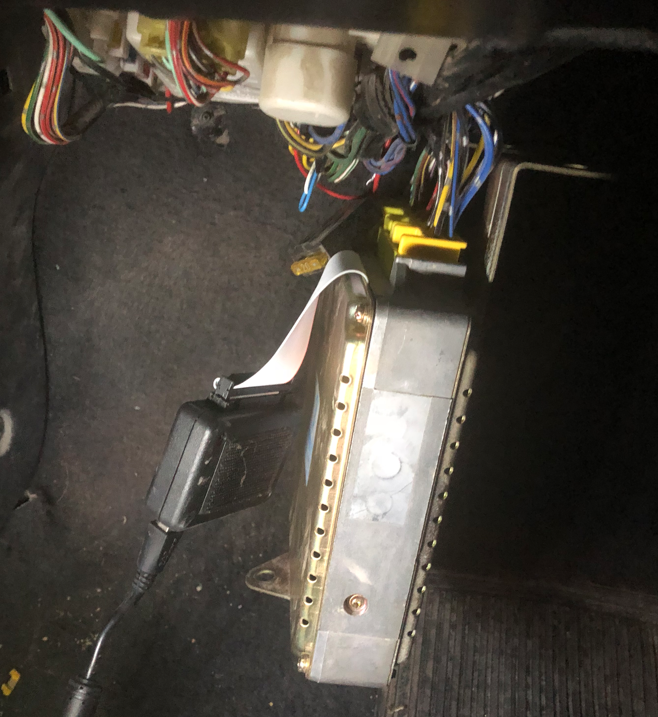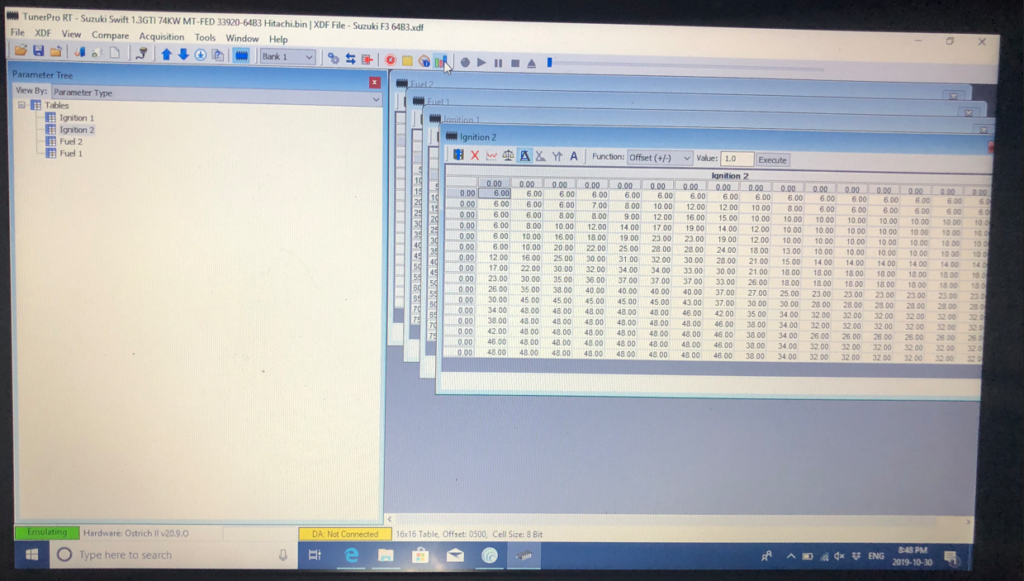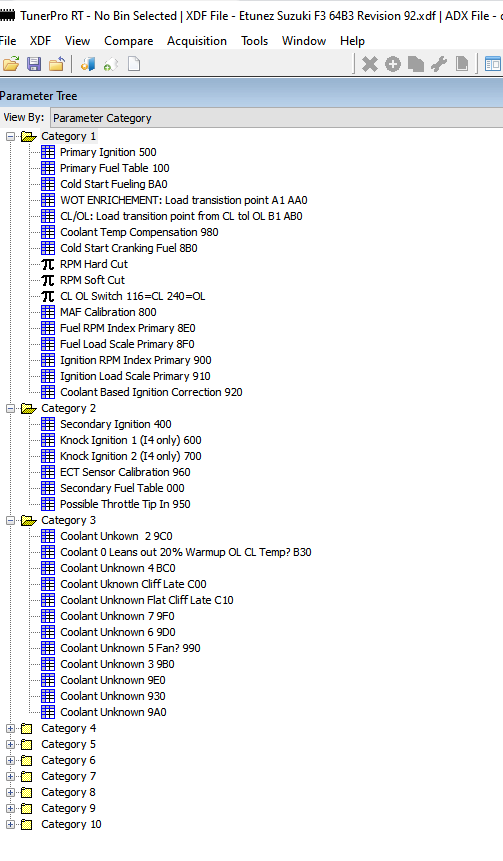Etunez Tuning information for the 1989-1994 Suzuki Swift GT(I)

| 1989 Suzuki Swift GT information. I own one of these cars personally and am providing this information based on my own research and development. How to Tune: While there are number of standalones solutions available for live/remote tuning of the Suzuki G13 ECU, being able to edit the factory ECU tuning data offers a reliable and economical solution, at the cost of a large time investment in decompiling the binary date to locate tables and change them. In order to tune with this approach, the factory ROM must be located inside the ECU physically, unsoldered and removed, and then “read” in a chip reader, and the binary must be decoded. In place of the factory ROM and socket is installed, so that future chips and be replaced with ease. In this particular case, the socket is connected to a MOATES Ostrich 2.0, which is a EEPROM Emulator, and has the ability to “look” like the factory chip, to the ECU, if the factory binary is installed in the emulator. That is what is happening here. The Moates Ostrick is being installed to the outside of the ECU, and connected via a ribbon cable to the factory ROM socket:  In summary, the stock ROM will be unsoldered and in its place a ribbon cable leading to an emulator will be installed. That emulator will connect to a PC via a USB cable. It could be external to the ECU like the Ostrich was, or it could be internal like the new Demon 2 is. The PC will run TunerPro RT and connect to that emulator, and can then live edit the ROM, provided the stock ROM tables locations and functions have been defined, as the ROM now exists in the emulator. That is the purpose of an XDF file, more to follow on that. After this, the emulator can be interfaced with software such as TunerPro RT: https://www.tunerpro.net/downloadApp.htm This software allows the binary to be manipulated. The .bin file can simply be opened, by the software itself, but it requires a 2nd file to be opened as well, a definition file must be either supplied or created, that says where in the binary, the tables are located, and what their functions are. This definition file is called an XDF file, for the TunerPro software. Thank fully here, we have supplied the most comprehensive definition file for the Swift G13BB created, to date. We have spent much time decoding the different tables, and there is still more work to do. As of July/23 we still need to find some idle related tables (IACV/Idle target), and some startup tables, but this is a very comprehensive file, that allows almost all critical functions to be edited. You can see when we started here in 2019, we had only found fueling and ignition information:  XDF Info After nearly hundred revisions, the below XDF file will be useful for any wishing to tune the factory BIN. Again, this file is for TunerPro RT, and this definition information allows the stock ROM to be edited, one of the better ways to do this is with an EEPROM emulator, like that from Moates, but there are others that work as well, such as Transtronic’s Emulator. We have heard recently that Moates is no longer in business, so new solutions will have to be found in terms of emulators, and we will update here as those working solutions are found. This definition file has a significant amount of tables, and represents several hundred hours of work with a 1989 Suzuki Swift F3 Canadian ECU. A special thanks goes to contributions made by James H. and Seth S. as well. It has been noted that other Hitachi ECUs for the swift, like the F5/I3 and other series ECUs use similar tables as well, but that sometimes the primary and secondary roles are swapped for fuel/ignition/knock tables that are redundant. As of July 23, this is how the file looks now:  There are 10 categories of tables that I have setup in this XDF: Category 1 is proven/test and working, function as labelled. Category 2 are back up tables, or tables with “secondary” effects. These are the tables that can swap with primary tables on some ECUs. Category 3 are Coolant related tables whose function has not been proven, but track with ECT. Category 4 are read during a startup only, whose function has not been proven. Category 5 are likely scaling tables whose function has not been proven. Category 6 are idle related tables whose function has not been proven. Category 7 are tables that track with RPM whose function has not been proven. Category 8 are tables are likely scaling related… but again, whose function has not been proven. Category 9 tables, are the ghosts within the machine. They track, they have purposes, their curves are random, edits to their values result in random things. Definitely important, but still un-determined, function has not been proven. Category 10 tables never track, I am unable to see any “reads” in them, they appear to go straight to Ram, and I do not know their purpose, yet. This XDF will be updated from time to time as more discoveries are made. The next step is to decompile the ROM and decode the references to the above unknown tables to gain more functions. I have noted that @ 70% load the ECU will switch into WOT enrichment, I would love to find the coding for that function in the future to change that point. EDIT: Found! Now in Category 1 are WOT enrichment as well as CL/OL load cut off points. Its also important to note that the numbers in the MAF determine the “load”. Not just TPS, its a combination of both. This might sound obvious but to clarify the issue, a MAF curve that is not correct can result in 100% load almost all the time, even if the fuel tables have been adjusted for perfect AFRs. Something to keep in mind. Download link: Etunez-Suzuki-F3-64B3-Revision-92.zip This is the factory Suzuki F3 ECU Bin file: Stock-F3-Binary.zip The below dyno tuned file, is for the G13B engine on a F series ECU with a stock MAF, proper set and zero’d timing, an intake, genie header and an 2-2.5″ exhaust. SuzukiSwiftF3GTICRC.Rev17Dyno.bin The below dyno tuned file, is for the G13B engine on a F series ECU with a Nissan 3″ MAF, Nissan K24a TB, and TPS, along with proper set and zero’d timing, an intake, genie header and an 2-2.5″ exhaust. SuzukiSwiftF3GTICRC.Rev58Dyno.bin These files should help you get started with TunerPro, and even without a Moates/TransTronic or other emulator, an old school chip burner is an option just to unsolder and replace the factory chip, if you know you are not going to be changing things up too often. |

